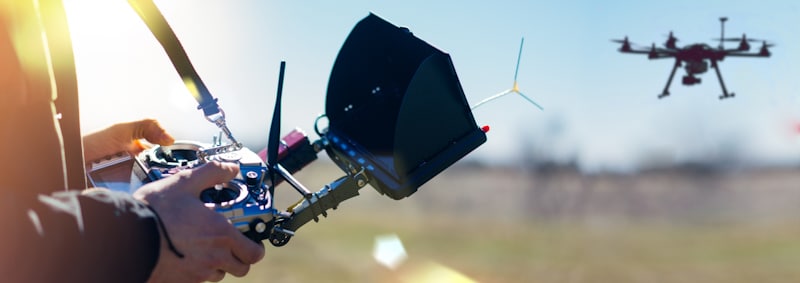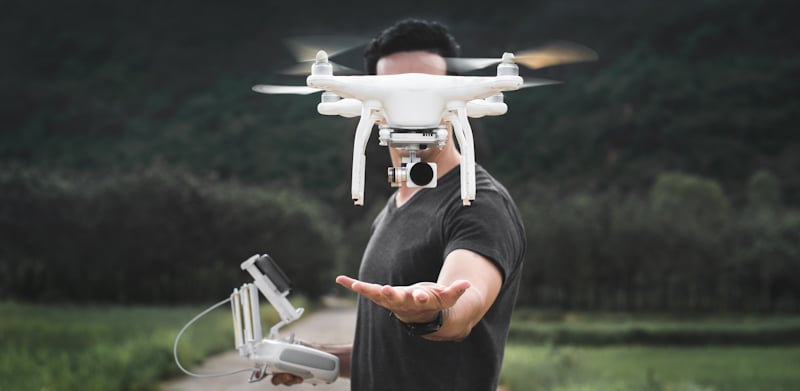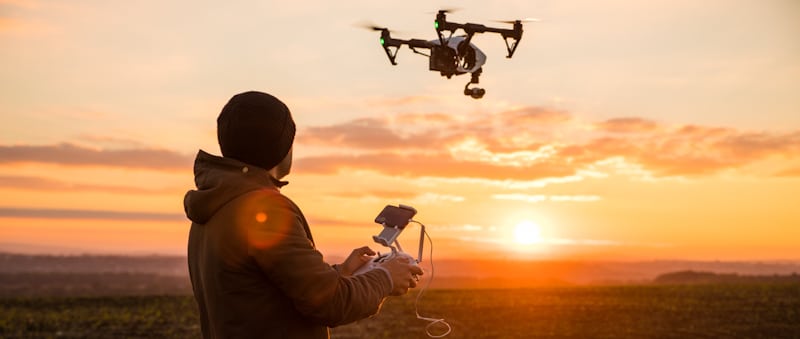Today drones are growing in popularity. More and more people are owning and flying them. This is a great hobby for people of all ages to enjoy.
Owning a drone can be a lot of fun but there are some rules that you must follow. Some of the rules you need to follow include flying under 400 feet high, maintaining your drone within your line of sight, and not flying within 5 miles of an airport. Following these rules is important.

Register Your Drone with the FAA (Federal Aviation Administration)
It's important for your new drone to weigh between 0.55 – 55 pounds. Drones that weigh any more than 55 pounds fall under the jurisdiction of the FAA. Regardless of the weight of your drone, you'll need to register it with the FAA before you're legally allowed to fly it. You must be over 13-years-old to register your drone. As part of this registration process, you'll be charged a fee of $5.
Upon completion of your registration, you'll immediately receive your registration number. You must affix this registration number to your drone before you fly it. The FAA also requires you to label your drone with your contact information but this is actually a good thing to do anyway since it'll allow you to be able to retrieve your drone if something happens and you lose it.
While you may think that this process wouldn't be quick and easy, you'd be wrong. This is a fast, easy process that will ensure that your drone is allowed to fly legally within the United States today.
Maintain Visual Line of Sight
Maintaining a visual line of sight on your drone simply means that you're able to see your drone in plain sight at all times. In other words, you can't simply rely on your drone's FPV camera to see where it's flying nor can you use any other type of vision-assisted aid (e.g. binoculars, telescopes) to see where you're at. You also need to make sure to check your local weather conditions before taking off for a flight. This is important because things like fog and clouds can impede the visual line of sight of your drone as well.
Don’t Fly After Dark
Since according to the law you must maintain a visual line of sight on your drone at all times, it should make sense that you aren't allowed to fly your drone after dark. Even if you equip your drone with night lights you still can't fly it after dark.
Dark is defined according to civil twilight. This defines it as 30 minutes before the sun is officially set to rise as well as 30 minutes after the sunsets.
Know Where and When You Can Fly Legally
In order to fly your drone safely, you'll want to maintain a visual line of sight on it at all times. This is why you should only fly during daylight hours and when the weather is nice outside. Some of the other things you should keep in mind when selecting a location where you can legally fly your drone include:
- You can't fly your drone within 5 miles of an airport without first asking for airspace authorization. This is because the airspace around an airport is considered controlled airspace. If you do get authorization to fly there you'll have some limitations regarding altitude and other operational provisions imposed upon you. You can ask for this authorization with the B4UFLY app which will get you an answer almost instantaneously.
- You can't fly your drone directly over the top of anyone who isn't involved with flying your drone. Doing so is considered an invasion of privacy.
- You can't fly inside of a national park. National park rangers may confiscate your drone, impose a fine, and you may even find yourself facing jail time. These rules have been instated because officials believe that drones are noisy and disruptive to the animals who live in the park, as well as anyone who's visiting the park.
- There are restrictions you must comply with when flying your drone in and around stadiums, schools, hospitals and power plants. You can learn about such restrictions by using the FAA's B4UFLY Smartphone App. Some of the safest places for you to legally fly your drone include public parks, national forests, state parks, private property, airports in uncontrolled airspace, beaches, and any other area that's designated as Class G Airspace.
How to Use the B4UFLY App
To ensure that you're flying your drone someplace that's deemed "legal," you should use the B4UFLY app. There are four different zone types that are listed here which you should be aware of. These include:
- Red represents restricted zones. You won't be allowed to fly here without requesting permission to do so first.
- Yellow represents authorized zones. You are allowed to fly here only if you're a verified user.
- Green represents enhanced warning zones. You can fly here but use caution.

Stay Below 400 Feet
According to the FAA, you shouldn't fly your drone above 400 feet AGL (Above Ground Level: the height from the ground or earth upwards) in the United States or above 295 feet AGL in Canada. This is because if you're flying your drone any higher up in the sky you could possibly conflict with manned aircraft (e.g. airplanes, helicopters). It's your responsibility to not only know the laws in this regard depending upon where you fly but also to follow them at all times.
Understand Commercial Restrictions
Whether you want to record a video of an event or take aerial photographs of something you must abide by commercial restrictions regarding drone flight. One of the biggest things you need to know before engaging in any of these activities with your drone is that you'll be required to have a license from the FAA and insurance to cover whatever activities your drone will be participating in. Typically a homeowner's policy won't cover any potential damages that have been caused by the commercial use of your drone.
Applying for a Commercial Drone License
Drones being used for commercial purposes are covered by the FAA's Small UAS Rule (Part 107). Herein it clearly states that in order to use your drone for commercial purposes you'll need to obtain a Remote Pilot Certificate. This is your opportunity to demonstrate that you understand the regulations, requirements, and procedures you must follow in order to fly your drone safely.
To be eligible to even apply for this type of license there are a few requirements. These include:
- Be at least 16-years-old
- Be able to read, speak, write, and understand English
- Be in good physical and mental condition
If you meet these requirements, you're eligible to apply for your license which will be good for two years. Every two years you'll need to take a recurrent knowledge test. The steps you must take here are as follows:
- You must first obtain an FAA Tracking Number (FTN). To do this you must create an Integrated Airman Certification and Rating Application (IACRA) profile.
- Once you have your paperwork in order you'll need to schedule an appointment with a Knowledge Testing Center to take the exam. When you go to take the exam you'll need to bring a government-issued photo ID with you.
- You'll need to pass the aeronautical knowledge test. This test will include questions regarding regulations about small unmanned aircraft system rating privileges, limitations, and flight operation; airspace classification and operating requirements; flight restrictions affecting small unmanned aircraft operation; aviation weather sources and effects of weather on the performance of small unmanned aircraft; emergency procedures; managing a crew; handling radio communications; determining the performance of small unmanned aircraft; the physiological effects of drugs and alcohol on operating small unmanned aircraft; information regarding aeronautical decision-making and judgment; airport operations; and maintenance and preflight inspection procedures.
- After you've passed your test you must complete FAA Form 8710-13 for a remote pilot certificate (FAA Airman Certificate and/or Rating Application). This can be done through the FAA Integrated Airman Certificate and/or Rating Application system (IACRA). To do this you'll need to log in to the system and select "Start New Application." Here you'll select "Pilot" as the application type. You'll want to apply for the "Remote Pilot" certification. You'll be prompted to enter your 17-digit Knowledge Test Exam ID then provide your electronic signature before submitting the application for processing.
- Once your TSA security background check has been completed you'll receive a confirmation email. This will tell you how to print out a copy of your temporary remote pilot certificate from IACRA. You can use this to fly your drone on commercial business while waiting for your permanent remote pilot certificate to arrive in the mail.

Conclusion
Flying a drone can be a lot of fun but it's important that you do so legally. For this to happen you must know what rules you're responsible for following and actually take the time to make sure you're following them. Fortunately, none of these rules are difficult so you'll be able to enjoy flying soon after you've purchased your drone.
Similar post: Drone Pilot License: Getting Started With Drone Pilot School
Shawn Manaher loves to play with new toys and dive into new hobbies. As a serial entrepreneur, work definitely comes first but there is always room for hobbies.

